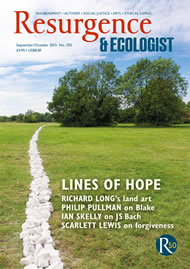Appledore, set elegantly on the edge of the North Devon coast and at the confluence of the Rivers Taw and Torridge, is a village that revels in contrast. White stuccoed villas oversee a working shipyard and a (now empty) dry dock. Sandy Brown’s studio stands out from the grace and magnificence of the river edge with a blast of colour: there is no reticent white here, but vibrant kingfisher colours. The building announces her passion for scale and colour.
And so it is no surprise to find here that Brown has embarked, with her customary zeal, on a project that is magnificent in conception, complex in delivery and dramatic in scale. She calls it a Temple. It is built for the purpose of introspection: a Temple for the Self. The building is profoundly extrovert: covered with her hand-painted tiles, inside and out; illuminated internally through handmade glass portholes by Simon Moore. A ceramic serpent writhes across one Gothic window.
This new building is for display at Chatsworth House and has been commissioned for the annual selling exhibition of monumental sculpture Beyond Limits organised by Sotheby’s (14 September – 25 October 2015). This is a title that might have been conceived with Brown in mind. The project might be traced back to her commanding touring exhibition (2007–9)
The Still Point and the Dance, which began, modestly enough, with a passageway through a Japanese tea room, before the explosive drama of totemic ceramic pillars and bold, expressive paintings. Here the tea room established a kind of quietism, a pause and preparation before the vigour of the exhibition to come. It enabled step change.
Brown has developed this idea of the graduated entrance. The approach to the building is a slow one. The visitor has to navigate stepping stones and pass through three ceremonial arches. We walk in transition. We have to stoop to enter the building through a circular gap designed to curtail onrush. For she wants to slow us down, to emphasise pause; she wants us to focus on the inner and the self in this remarkable site. For all of the focused pace of her glaze painting, the vigour and the swirl of it, the space inside the building is designed for intimate reflection. She wants her Temple to be “a space for contemplation”, a place of rare thought, since “we don’t have in our culture non-denominational or sacred places which are spiritually uplifting”. This is an extrovert place for introvert muse.
The idea of the Temple has been dormant in Brown’s mind for some time. She recalls her travels to Iran as a young adult, and the deep impression made during her visit to the Jameh Mosque in Isfahan, “full of abstract colour”, with its remarkable seven-colour mosaic tiles and calligraphic inscriptions, its dome covered with polychrome tiles giving a sense of spiritual transcendence. Perhaps the domes and finials of Venice, seen in a more recent trip, have enriched the vocabulary of her Temple, too. It makes, say, Beckford’s doomed Fonthill Abbey seem almost reasonable. I see this idiosyncratic building wresting the tradition of pavilions sited in the grounds of great country houses into a modern age of cultural reference. This is a serious as well as a playful architecture, like the wonderful Sitooteries (places of private reflection) commissioned by Judith King for Belsay Hall in Northumberland in 2000, or even Grayson Perry’s present-day Essex House, described by Rowan Moore as “like a secular church”.
Brown uses colour and ceramic to vitalise her building: to animate a static place through highly expressive painting and the sheen of her glaze. The building is a symbol of her search for a spiritual moment of peace, and the hope that visitors to the exotic room will find it too. Her Temple shocks the heritage space around it. It glimmers with light bouncing off a thousand individual tiles. The inner walls are conceived as huge tile-panel-paintings; the outer walls are vibrant and spirited, colour bombarding us at every turn. Everything about the project construction is meticulously measured and exact, but this control underpins an exultant sense of freedom and improvisation about the glaze painting. Chance also applies in the way the roof tiles have been randomly placed as they come out of the boxes on site, “forming their own pattern as the Universe dictates”.
This building is a tribute to Brown’s creative energy, her inability to stop still, and her love of challenge. It is a building that is exacting and regulated, eccentric and abandoned, all at once. She has made a place at a scale (four metres square and more than five metres tall) that seems to defy logic, “the biggest thing I have ever done”. The confidence of the work and its frenetic order enforce her view “that the abstract is a portal to our thoughts and feelings”. Her Temple is a conundrum: a riot of colour that marks “a space for ourselves and our self”.
The Temple, among other things, helps us to understand the impact of Brown’s studio on the white of Appledore, the vibrant blue punctuating the white stucco. It is an architectural façade shouting aloud in the village, just as this building punctuates the shady bower of Chatsworth. It has helped Brown to think about her own need for restfulness and pause. It is cavalier as well as redemptive. Peace comes in a riot of colour, in the vigour of her painting.
The Temple, as with all of Sandy Brown’s work, “expresses the moment in which it was made”; it is, as she goes on to say, “a dance of clay and glazes”.
Sandy Brown is a Resurgence Trustee and is Art Adviser to Resurgence & Ecologist. www.sandybrownarts.com Temple is presented by curator Joanna Bird, Sandy Brown’s agent for the project. www.joannabird.com







